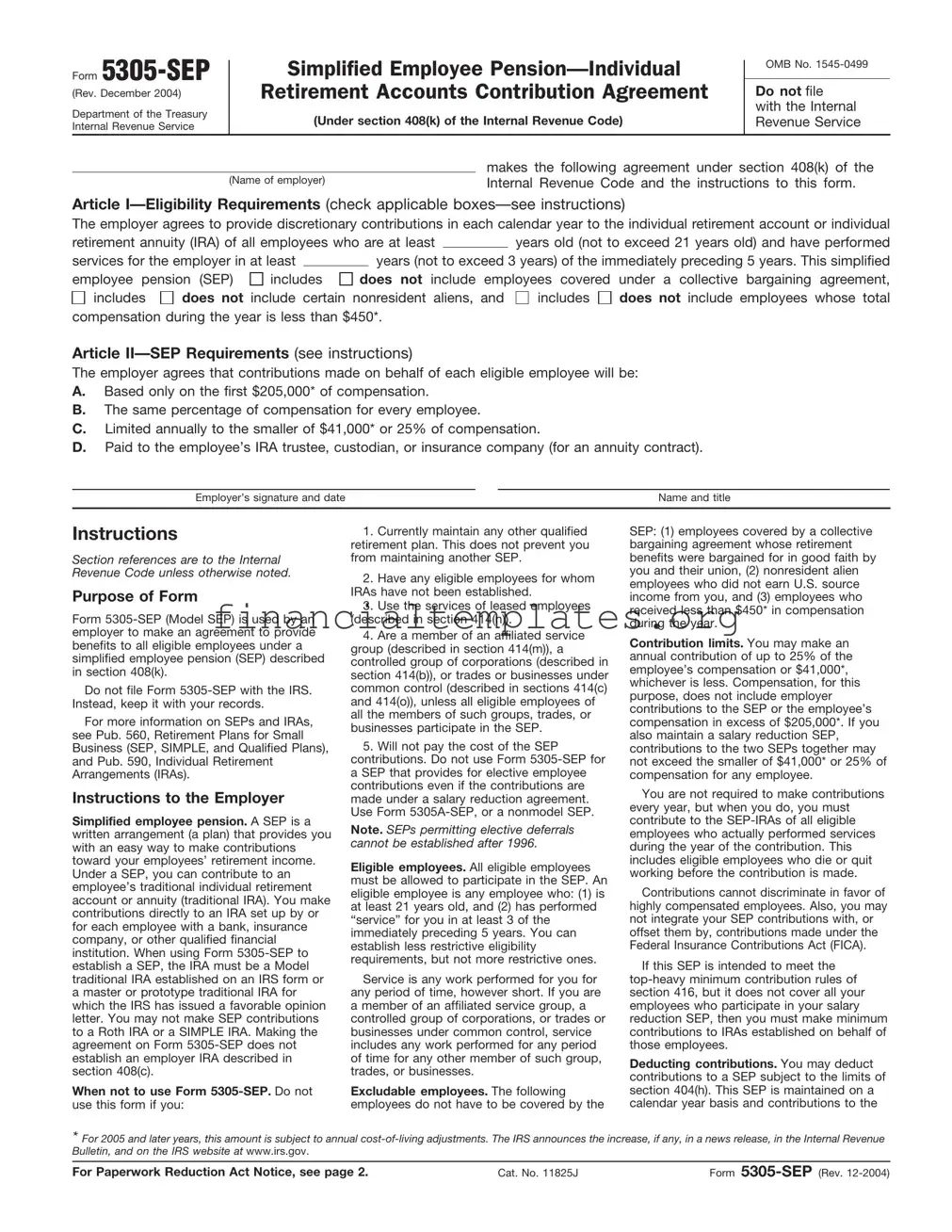SEP are deductible for your tax year with or within which the calendar year ends. Contributions made for a particular tax year must be made by the due date of your income tax return (including extensions) for that tax year.
Completing the agreement. This agreement is considered adopted when:
●IRAs have been established for all your eligible employees;
●You have completed all blanks on the agreement form without modification; and
●You have given all your eligible employees the following information:
1.A copy of Form 5305-SEP.
2.A statement that traditional IRAs other than the traditional IRAs into which employer SEP contributions will be made may provide different rates of return and different terms concerning, among other things, transfers and withdrawals of funds from the IRAs.
3.A statement that, in addition to the information provided to an employee at the time the employee becomes eligible to participate, the administrator of the SEP must furnish each participant within 30 days of the effective date of any amendment to the SEP, a copy of the amendment and a written explanation of its effects.
4.A statement that the administrator will give written notification to each participant of any employer contributions made under the SEP to that participant’s IRA by the later of January 31 of the year following the year for which a contribution is made or 30 days after the contribution is made.
Employers who have established a SEP using Form 5305-SEP and have furnished each eligible employee with a copy of the completed Form 5305-SEP and provided the other documents and disclosures described in Instructions to the Employer and Information for the Employee, are not required to file the annual information returns, Forms 5500 or 5500-EZ for the SEP. However, under Title I of the Employee Retirement Income Security Act of 1974 (ERISA), this relief from the annual reporting requirements may not be available to an employer who selects, recommends, or influences its employees to choose IRAs into which contributions will be made under the SEP, if those IRAs are subject to provisions that impose any limits on a participant’s ability to withdraw funds (other than restrictions imposed by the Code that apply to all IRAs). For additional information on Title I requirements, see the Department of Labor regulation at 29 CFR 2520.104-48.
Information for the Employee
The information below explains what a SEP is, how contributions are made, and how to treat your employer’s contributions for tax purposes. For more information, see Pub. 590.
Simplified employee pension. A SEP is a written arrangement (a plan) that allows an employer to make contributions toward your retirement. Contributions are made to a traditional individual retirement account/annuity (traditional IRA). Contributions must be made to either a Model traditional IRA executed on an IRS form or a master or prototype traditional IRA for which the IRS has issued a favorable opinion letter.
An employer is not required to make SEP contributions. If a contribution is made, however, it must be allocated to all eligible employees according to the SEP agreement. The Model SEP (Form 5305-SEP) specifies that the contribution for each eligible employee will be the same percentage of compensation (excluding compensation greater than $205,000*) for all employees.
Your employer will provide you with a copy of the agreement containing participation rules and a description of how employer contributions may be made to your IRA. Your employer must also provide you with a copy of the completed Form 5305-SEP and a yearly statement showing any contributions to your IRA.
All amounts contributed to your IRA by your employer belong to you even after you stop working for that employer.
Contribution limits. Your employer will determine the amount to be contributed to your IRA each year. However, the amount for any year is limited to the smaller of $41,000* or 25% of your compensation for that year. Compensation does not include any amount that is contributed by your employer to your IRA under the SEP. Your employer is not required to make contributions every year or to maintain a particular level of contributions.
Tax treatment of contributions. Employer contributions to your SEP-IRA are excluded from your income unless there are contributions in excess of the applicable limit. Employer contributions within these limits will not be included on your Form W-2.
Employee contributions. You may make regular IRA contributions to an IRA. However, the amount you can deduct may be reduced or eliminated because, as a participant in a SEP, you are covered by an employer retirement plan.
SEP participation. If your employer does not require you to participate in a SEP as a condition of employment, and you elect not to participate, all other employees of your employer may be prohibited from participating. If one or more eligible employees do not participate and the employer tries to establish a SEP for the remaining employees, it could cause adverse tax consequences for the participating employees.
An employer may not adopt this IRS Model SEP if the employer maintains another qualified retirement plan. This does not prevent your employer from adopting this IRS Model SEP and also maintaining an IRS Model Salary Reduction SEP or other SEP. However, if you work for several employers, you may be covered by a SEP of one employer and a different SEP or pension or profit-sharing plan of another employer.
SEP-IRA amounts—rollover or transfer to another IRA. You can withdraw or receive funds from your SEP-IRA if, within 60 days of receipt, you place those funds in the same or another IRA. This is called a “rollover” and can be done without penalty only once in any 1-year period. However, there are no restrictions on the number of times you may make “transfers” if you arrange to have these funds transferred between the trustees or the custodians so that you never have possession of the funds.
Withdrawals. You may withdraw your employer’s contribution at any time, but any amount withdrawn is includible in your income unless rolled over. Also, if withdrawals
occur before you reach age 591⁄2, you may be subject to a tax on early withdrawal.
Excess SEP contributions. Contributions exceeding the yearly limitations may be withdrawn without penalty by the due date (plus extensions) for filing your tax return (normally April 15), but are includible in your gross income. Excess contributions left in your SEP-IRA after that time may have adverse tax consequences. Withdrawals of those contributions may be taxed as premature withdrawals.
Financial institution requirements. The financial institution where your IRA is maintained must provide you with a disclosure statement that contains the following information in plain, nontechnical language:
1.The law that relates to your IRA.
2.The tax consequences of various options concerning your IRA.
3.Participation eligibility rules, and rules on the deductibility of retirement savings.
4.Situations and procedures for revoking your IRA, including the name, address, and telephone number of the person designated to receive notice of revocation. This information must be clearly displayed at the beginning of the disclosure statement.
5.A discussion of the penalties that may be assessed because of prohibited activities concerning your IRA.
6.Financial disclosure that provides the following information:
a. Projects value growth rates of your IRA under various contribution and retirement schedules, or describes the method of determining annual earnings and charges that may be assessed.
b. Describes whether, and for when, the growth projections are guaranteed, or a statement of the earnings rate and the terms on which the projections are based.
c. States the sales commission for each year expressed as a percentage of $1,000.
In addition, the financial institution must provide you with a financial statement each year. You may want to keep these statements to evaluate your IRA’s investment performance.
Paperwork Reduction Act Notice. You are not required to provide the information requested on a form that is subject to the Paperwork Reduction Act unless the form displays a valid OMB control number. Books or records relating to a form or its instructions must be retained as long as their contents may become material in the administration of any Internal Revenue law. Generally, tax returns and return information are confidential, as required by section 6103.
The time needed to complete this form will vary depending on individual circumstances. The estimated average time is:
Recordkeeping |
1 |
hr., 40 |
min. |
Learning about the |
|
|
|
law or the form |
1 |
hr., 35 |
min. |
Preparing the form |
1 |
hr., 41 |
min. |
If you have comments concerning the accuracy of these time estimates or suggestions for making this form simpler, we would be happy to hear from you. You can write to the Internal Revenue Service, Tax Products Coordinating Committee, SE:W:CAR:MP:T:T:SP, 1111 Constitution Ave. NW, Washington, DC 20224. Do not send this form to this address. Instead, keep it with your records.


